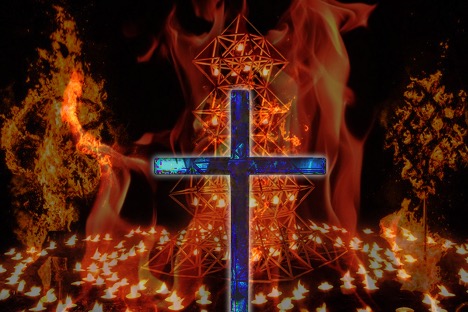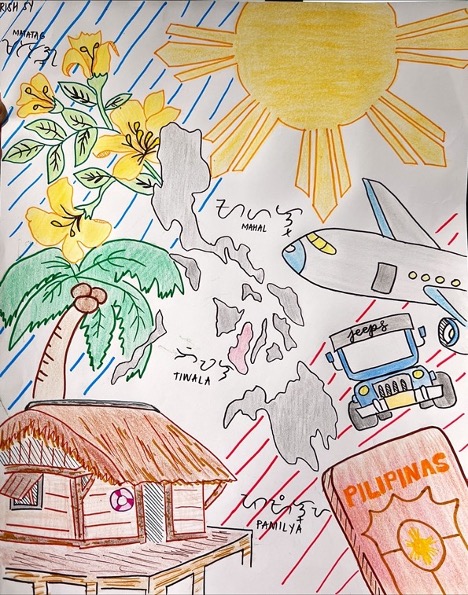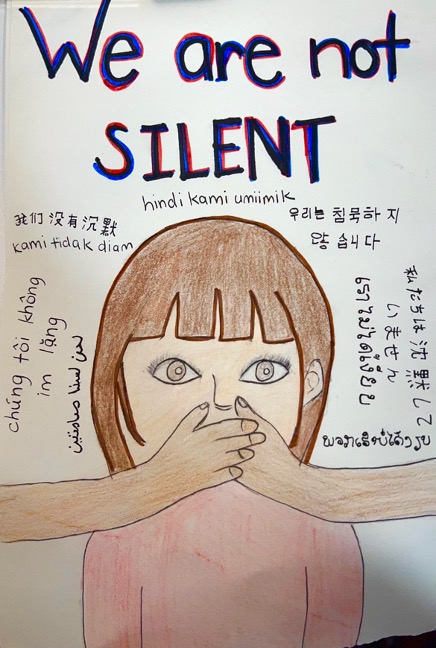SPR ’22: GLAS/ENGL 123—Introduction to Asian American Literature
Instructor: Mark Chiang
Final Projects: “Reflections of Community”
These student projects explore ideas of community, what creates or sustains it, how it is defined, and what kinds of relations connect each of them to community. The projects take a variety of forms, from poems, paintings, and personal essays to video interviews and family documentary, and I hope you find them as fantastic and thought-provoking.
Ernesto Angulo: "Face-to-face with Filipinos in Alliance Members: Asian-American Identity"
Throughout the fall semester, I’ve gotten to learn a lot about the Asian American community and relevant issues within the community. This final project was a great creative opportunity to be able to construct questions I raised regarding the Asian American community and hear first-hand from individuals involved in the organization Filipinos in Alliance. Throughout my three years here at UIC I’ve become really involved within FIA and met a lot of great friends along the way, including my roommates. I raised the following three questions: How has your identity as an Asian-American impacted your living in America? What generation student are you, and how do your beliefs differ from how your parents were brought up? Is Asian American community important to you? If so, how do you participate in this community?
Amyah Cardine: “Assimilation”

The piece shows how many immigrants assimilate in a symbolic form. This is demonstrated as the Japanese woman is watching the Japanese flag fly away from her in the wind, as her Japanese identity is going away from her. The sunset symbolizes the ending of her current Japanese identity with the sky still blue over the American city, which symbolizes that there will be a dawn of her new Americanized personality.
Jasmine Ferrer: “You bring out the Filipina in me.” A poem inspired by “You bring out the Vietnamese in me” by Bao Phi
You bring out the Filipina in me.
For years I’ve questioned my tainted skin. Wondering why I was always 10 shades darker than the rest of my kin. For I have to remember, that brings out the Filipina in me.
The island sweetheart of art. The “kain na”, so everyone has to show up at the dinner table in me.
The island stricken tropical paradise held together by the straps and her closet of over a thousand purses
The rich sunkissed skin that refuses lightening creams. Illocano and Lucbanin and Tagalog and my Spanish last name which was bestowed in me.
TFC playing in the background, turon-eating, Soon-to-be nurse in me. For my family’s dreams and inspirations were put onto me. And yet you still bring out the true Filipina in me.
The wealth of knowledge, once I graduate from college, needs to make a difference for my family’s legacy in me.
You are the one I turn to, for our home is built with always-open doors, kind gentle wind reflecting the plastic-covered couches, fully-stocked pantry piled high with cans of Spam, walis-swept floors, and sometimes getting palo with a wooden spoon for being naughty to me.
You are the rays of sun on my very own flag, the guiding stripes that surround me.
You have taught me the truth of mahal kita and salamat, for I love to give thanks when it is not required. Teaching me mano po and ways to respect our elders. When welcoming a neighbor with gifts. You’ve brought out the Filipina in me.
You have been woven into the mosquito nets that shield me, the tropical leaves that shelter me from the scorching sun, the clothes you’ve made by hand in which protect my soft melanin skin. You are the protector of me.
Goda Kurpalis: “Lithuanian Religions”

This is a digital collage made to show the contrast of the religion that Lithuanians identify with, Catholicism, and the traditions that were taken or borrowed from paganism. I wanted to express the recent confusions I have gone through when trying to figure out which religion I should take part in: the newer, more popular Catholicism or the traditional paganism. I also wanted to bring attention to just how many pagan holidays were rewritten to be more acceptable in Catholicism, like how midsummer turned to a celebration of the birth of St. John, even though all the rituals of bonfires and dances stayed the same.
Laryzza Lazaro: “Home Away From Home”

Growing up as a Filipino American has many ups and downs. In my piece, I wanted to portray the beauty and the not-so-pleasant aspects of being Filipino in America while adding my own and my friends’ experiences while living here. If you have ever gone through similar experiences like this, know that you are not alone 🙂
Alicia Ribeiro: “Gifts from Haraboji”
This video was created from video clips of a family gathering celebrating my great-grandfather’s, or as we all call him, Haraboji’s, 95th birthday. He came from Korea to spend time with all of his descendants and brought us gifts. The act of gift giving is an important part of Korean culture and signifies a feeling of belonging to a community. I hope to capture the inclusiveness of the international, mixed, and blended nature of my family with this video.
Music credits: Kim Won Mi
Kim Won Mi, a concert pianist, is my grandmother’s sister. She was unable to attend the event but her music represents part of the dedicated culture that characterizes my family.
Chad Shahriyar: "/broun/"
“Another reason we shy to frequent dere is dat we is watered-down Indians-we ain’t good grade A Indians. We skin is brown, is true, but we doh even think ‘bout India unless something happen over dere and it come on de news.” – Out on Main Street by Shani Mootoo
For a large part of my life, I think I’ve always struggled with identity. Of course, there’s the melodramatic self reflection that comes with being a teenager, but beyond that, I’ve always been slightly confused. Growing up in Uptown which is a predominantly Black and East Asian community, I rejected my own racial identification. I wasn’t ashamed of it, but I just didn’t think about it too much because somewhere deep down I knew I wouldn’t be able to really find an immediate answer. So, I looked for other means of connection.
In elementary and middle school, everyone I knew was poor and we generally shared similar interests. I honestly felt pretty connected to everyone I knew in some way because there wasn’t much that made anyone stand out. Well, in retrospect, being the only person of Indian descent did make me stand out just a bit, but I never felt that way and no one ever treated me that way.
However, things changed in highschool. Going from the practically unknown John T. McCutcheon, plotted abruptly in the middle of Sheridan, to the well-known Northside College Prep that dominates Kedzie marked a big shift in my life. Amongst other things, there was one thing about Northside I couldn’t help but notice: So. Many. Brown. People.
Ok, ok, ok. That sounds ridiculous; I mean, I’m brown! But, what does that even mean?
Let’s Google it:
Brown. /broun/. Adjective. 1. Of a color produced by mixing red, yellow, and blue, as of a dark wood or rich soil.
Hm.
Inevitably, there came the “So, you’re Indian, right?” questions from other Brown kids. And you know what? Yeah, I caved and answered with a simple “yes”; even though that doesn’t seem like a big deal, it was for me because I wasn’t entirely sure if that’s what I am.
Before I continue, I’m realizing that I haven’t actually said what I do consider myself and the whole quote from Mootoo’s Out on Main Street seems completely random. It’s not, I promise. But if I did tell you, do I still fit in with the Brown kids or do I stand out for the wrong reasons? Maybe it’s just better if I tell you. Alright, here we go. Deep breaths, deep breaths, deep breaths. The truth is…
I’m Trinidadian. “What?”
What?
“Where even is that?” The Caribbean.
“I thought you said you grew up in Uptown.” I did.
“So it’s like Hawaii, right?” Oh my God.
Ok, so it’s probably not what you were expecting. Most people have never even heard of Trinidad which, to be honest, I wouldn’t really blame them. It’s a small, chicken leg shaped island in the Caribbean near South America. It’s not powerful enough to war with (invade) and it’s never even made the Top 20 rank in the Olympics. Why would you know it?
That’s alright though. In short, there are people of African, Indian, and Chinese descent all on the island. For me personally, my family is Indo-Trinidadian which means I’m of Indian descent. So am I Indian? I mean, yeah. Wait. Maybe? I don’t know.
This is exactly the problem I encountered in highschool. Like I said before, I would often get asked if I’m Indian and I’d answer yes. A lot of times it would just get me through the conversation and it wouldn’t go any further than that, but sometimes, oh God, sometimes they’d press further. They’d ask me questions about certain cultural experiences they’ve had and would look to me for an inkling of relation and I’d have a very small sliver to offer, if that much.
The thing with Trinidad is that it’s very much developed its own culture. That seems painfully obvious, but you have to understand that even though technically I am Indian and I look Indian, I didn’t really see myself as Indian. There are definitely cultural overlaps, but there are also complete differences. The food we eat (not all curry is the same, believe it or not), the music we listen to (I can’t imagine showing “Congo Man” by Mighty Sparrow to anyone who didn’t grow up with it), and the way we talk can differ because of how different those worlds are.
Like Mootoo says, I didn’t consider myself to be Indian enough because of this. It wasn’t the most crippling thing in my life, but it also didn’t make me feel like I could ever actually relate to anyone else culturally. I felt like the odd one out, especially as culture is such a defining aspect of a person and the connections that they make.
However, my feelings about this changed. No, I didn’t magically find a hidden group of Trinidadians buried deep behind the bleachers, but over the past few years I’ve allowed myself to not be hindered by feeling like I’m not a part of the in-group.
My best friend is Nepali and a lot of my roommates and the friends I’ve made in college are Indian. I can’t say that we relate to everything when it comes to culture, but there’s a recognizable fabric woven amongst all of us. The most obvious one being that we’re all Brown.
Earlier when I asked for the definition, I knew it meant something and maybe you did too, but what?
It’s so easy to think about race and identity in a vacuum, especially when it becomes a discourse about what it is and what it can be. It’s easy to separate you and the people you know from it, to make it a discussion about an “other”. But when you and I step away from this screen, we’re still left with the color of our skin, the shape of our eyes, the size of our nose, and the texture of our hair.
My point being, no matter what I may identify as, I still look a certain way to someone else who doesn’t look like me. My Nepali friend and I know that we don’t identify the same culturally, but if someone who didn’t know either of us saw us walking down the street, would they know that?
This idea of looking and being looked at has shaped the way I think about the group that I belong to. I’m Trinidadian and my best friend is Nepali, nothing will ever change that. But, he and I are both subjected to the same prejudices and expectations that someone would impose upon us, knowingly or not. No matter what we identify as, we still share the same experience of being the only Brown person in the room. We share the same experience of “not being masculine enough” because Baljeet and Apu are most Americans’ only exposure to a Brown person.
This isn’t about erasing our identities, but about sharing them. Being Brown to me has stopped being what nation someone comes from and more about what experiences we share because we’re Brown. It’s more than just a color to me, it’s an instant visual signal that me and someone else have something in common. It could be the only thing! Sometimes it is. But who’s to say that isn’t enough?
Irish Kimberly Sy: “In the Motherland”

This piece represents the uniqueness of Filipino culture, and its beauty through my eyes. It highlights the yearning for home as an immigrant, and the deep connection OFW’s (Oversea Filipino Workers) have to the islands.
Jenny Zhu: “We Are Not Silent”

My piece conveys how stereotypes are just stereotypes and they don’t truly represent a community. With the rise of the pandemic, the Asian American community has been speaking up and rising up against hate crimes and violence towards the community, which tackles the common stereotype that Asian Americans are always “silent.” The work also demonstrates the importance of speaking up against hate, discrimination, or violence when we see it happen.